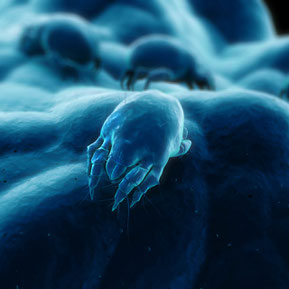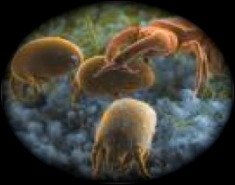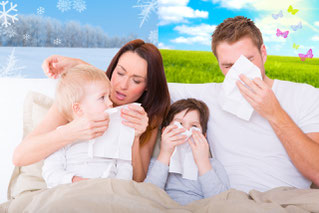What are they ?

Family: Arachnids (cousins of spiders)
Greek scientific name: Dermatophagoides pteronyssinus
Facts: invisible to the naked eye, they have 4 pairs of legs completed by hairs and claws. They can measure up to: 0.2 to 0.03 mm / 0.07 in to 0.01 depending on what kind
Life length: between 2 and 3 months
Scientifically discovered: 1920
Density: up to 1,500 dust mites per gram of dust / 50,000 for every ounce of dust, which means an average of 2 million dust mites per mattress
Proliferation temperature: between 20 and 30 C°
Food: 1.5 g / 0.05 oz. of dead skin feeds 1 million dust mites
The tolerance threshold is of 2 µg (micro gram) dust mites per gram of dust.
Within the medical profession, it is the alert threshold at the body starts producing antibodies in response to allergies (source: Platts-Mills et al., 1997).
What do they do ?
Dust mites live in a colony of several thousands. It spends the greater part of its life eating. Their best living condition is 25C / 75 F and 80% humidity. In such an environments, dust mites eat and reproduce 5 times more. Dust and dust mites droppings are spreading in the air with every movement on the mattress. It acts, as a blower that spins the fesses, dust mites and their dead remains which land back on:
- Our skin causing itching (eczema)
- Eyes (lacrimation, conjunctivitis)
- Mouth and nose, therefore affecting our respiratory system (rhinitis, asthma...).

What to do on a daily basis?

The presence of dust mite is not related to a hygienic problem; even the cleanest homes are infected. It is the concentration of dust mites that can become critical at any time of the year and at any age. These measures do not replace a medical check-up but contribute to reduce indoor pollution:
- Flatten: have a smooth and easy to wash floors (or carpet, or carpet)
- Ventilate: open your windows every day to reduce the temperature and the humidity in the room
- Purify: regularly wash bed sheets at 60 C / 140 F, place high quality bed sheets covers and/or use an anti-dust-mite spray (make sure the chemical substance are non-irritating to the respiratory system)
- Accumulation: Regularly clean and vacuum, 1 to 2 times per week to remove dust and avoid any accumulation.
- Altitude: If you decide to live in altitudes above 1500 meters, you’ll live dust mite free.
They can suffer too!
A high numbers of dogs suffer from allergies to dust mites. Like cats, they hardly tolerate the chemicals used in some anti dust mites sprays such as permethrin.
Our unique method of disinfection and the use of our anti dust mites spray has proven to be very effective to eradicate allergens from their basket


The disinfection of their baskets combined with the anti dust mite spray can help them greatly.
Making it possible for us to pet them, take good care and show the affection they deserve.
